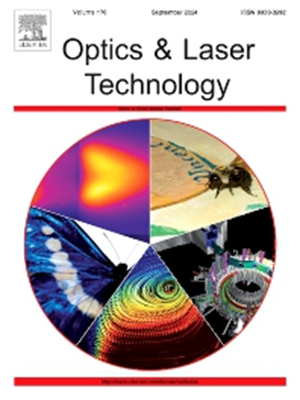Process parameter optimization for laser directed energy deposition B4C/Al neutron absorbing material via Taguchi method
IF 4.6
2区 物理与天体物理
Q1 OPTICS
引用次数: 0
Abstract
In this study, the fabrication process parameters of laser directed energy deposition (LDED) B4C/Al composites that can achieve the maximum relative density were obtained via Taguchi method. The single-track experiments were employed to determine the appropriate range of laser power, scanning speed, powder feeding speed and protective gas flow rate. Based on the values of these process parameters, an L16 orthogonal experiment was designed using the Taguchi method, and the signal-to-noise (S/N) ratio analysis and analysis of variance (ANOVA) were performed to obtain the LDED process parameters that can achieve the B4C/Al composites with maximum relative density. And the regression equation and fabrication of bulk composite were adopted to verify the effectiveness of the optimized process parameters. The optimal combination of process parameters was laser power of 1600 W, scanning speed of 350 mm/min, powder feeding speed of 2.0 r/min, and protective gas flow rate of 8.5 L/min. This study will help to establish an effective process for fabricating B4C/Al composite using LDED.
求助全文
约1分钟内获得全文
求助全文
来源期刊
CiteScore
8.50
自引率
10.00%
发文量
1060
审稿时长
3.4 months
期刊介绍:
Optics & Laser Technology aims to provide a vehicle for the publication of a broad range of high quality research and review papers in those fields of scientific and engineering research appertaining to the development and application of the technology of optics and lasers. Papers describing original work in these areas are submitted to rigorous refereeing prior to acceptance for publication.
The scope of Optics & Laser Technology encompasses, but is not restricted to, the following areas:
•development in all types of lasers
•developments in optoelectronic devices and photonics
•developments in new photonics and optical concepts
•developments in conventional optics, optical instruments and components
•techniques of optical metrology, including interferometry and optical fibre sensors
•LIDAR and other non-contact optical measurement techniques, including optical methods in heat and fluid flow
•applications of lasers to materials processing, optical NDT display (including holography) and optical communication
•research and development in the field of laser safety including studies of hazards resulting from the applications of lasers (laser safety, hazards of laser fume)
•developments in optical computing and optical information processing
•developments in new optical materials
•developments in new optical characterization methods and techniques
•developments in quantum optics
•developments in light assisted micro and nanofabrication methods and techniques
•developments in nanophotonics and biophotonics
•developments in imaging processing and systems

 求助内容:
求助内容: 应助结果提醒方式:
应助结果提醒方式:


